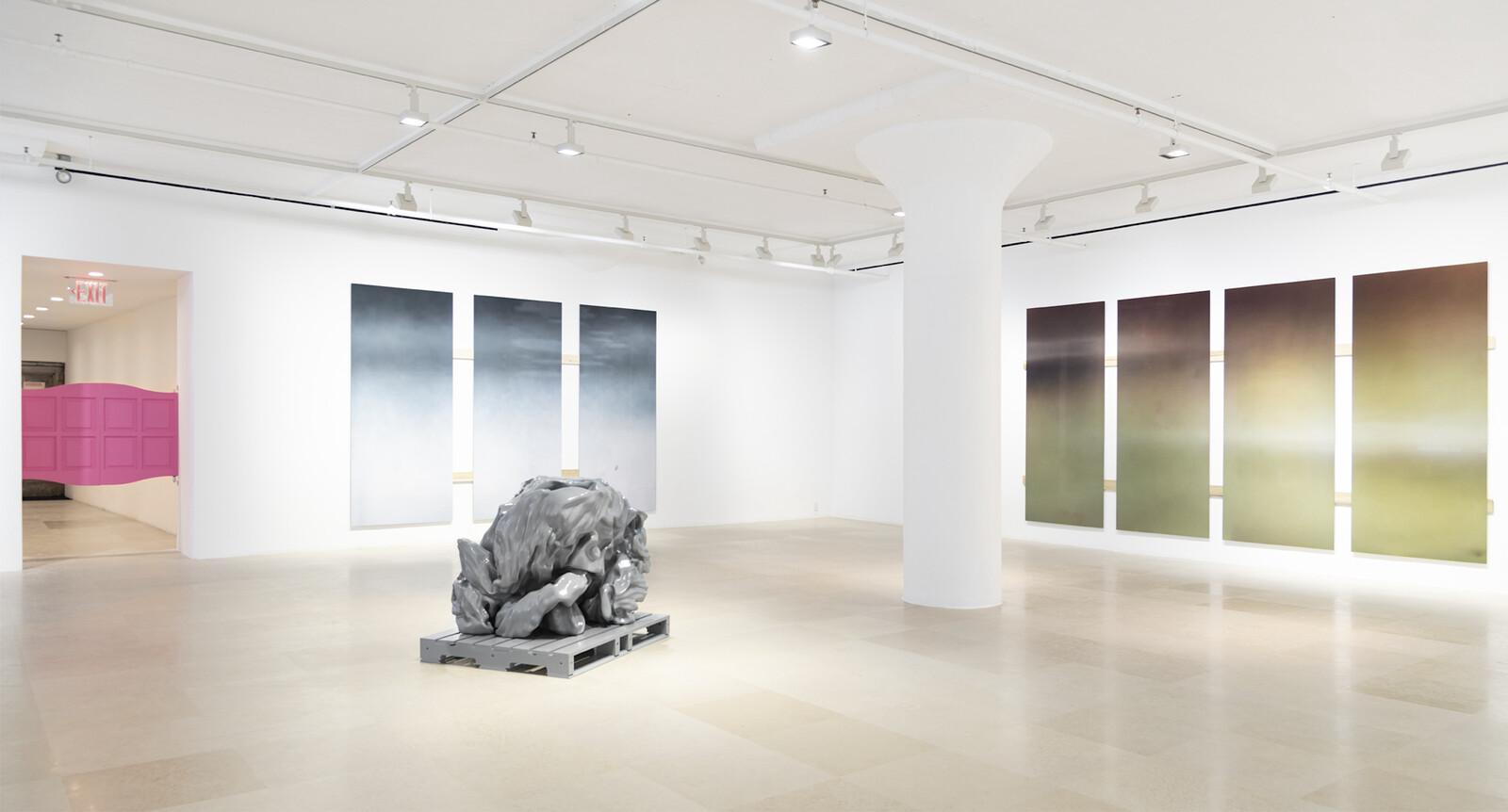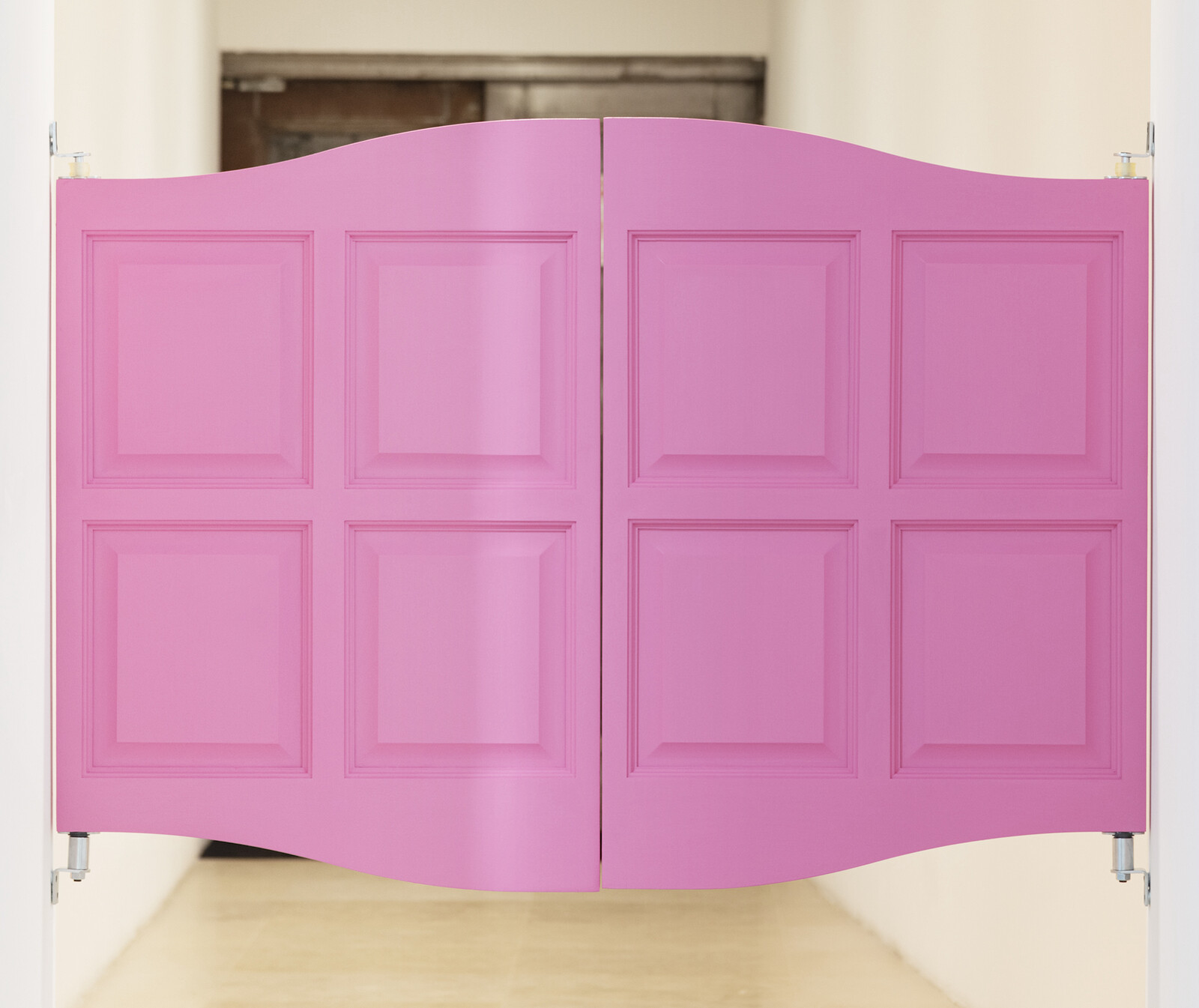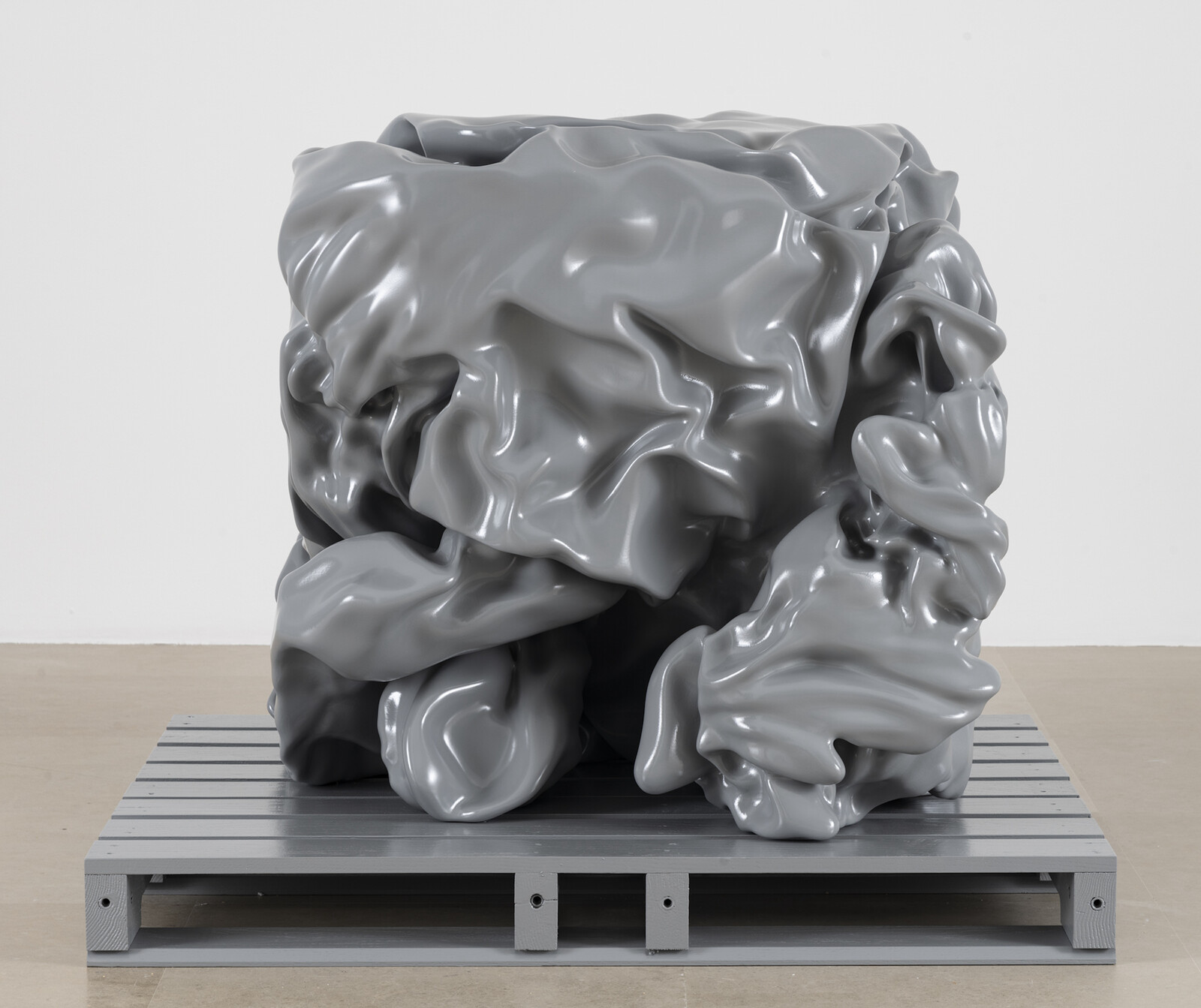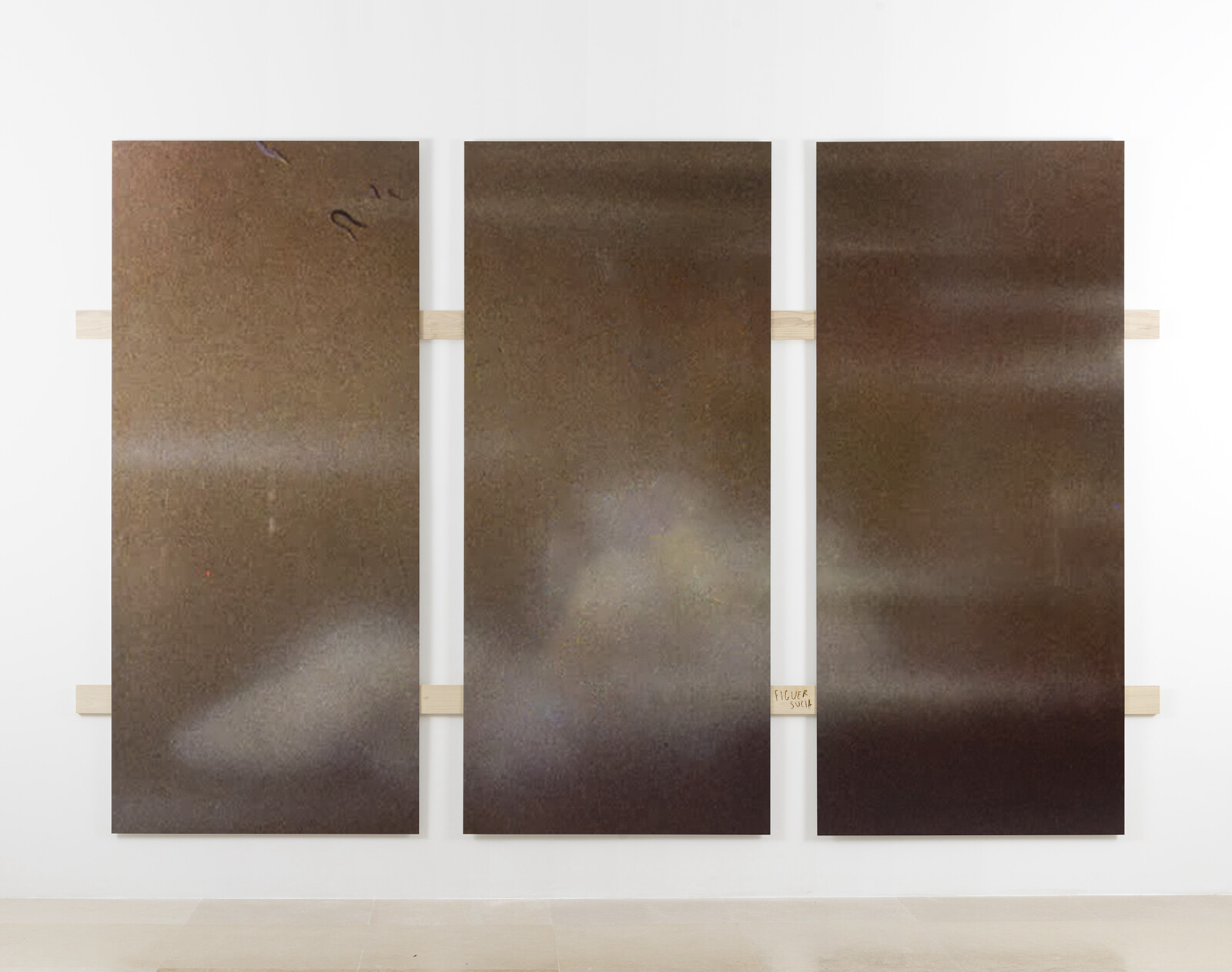One enters Aria Dean’s exhibition “Figuer Sucia” through Pink Saloon Doors (all works 2023) that open onto a vaguely neo-Western mise-en-scène. An ambiguous gray sculpture—heavily textured, with densely packed contours that evoke layers of folded skin and the crushed musculature of a horse—sits on a wooden pallet at the center of the room. This mildly cubic, contorted sculptural figure (FIGURE A, Friesian Mare) appears to be cowering, its subject’s equine body nearly unrecognizable. Dean’s recent exhibition at the Renaissance Society, “Abattoir, U.S.A.!,” took the slaughterhouse as a way to examine the limits of subjecthood. Its central film work walked the viewer through the environments of factory farming. While Abattoir, U.S.A.!’s featured architecture was outfitted for the killing of animals, the rooms it showed remained empty, painting a backdrop of violent and eerie subjectification. Like that project, “Figuer Sucia” is implicitly connected to Dean’s longstanding reflections on how Blackness is conditioned for and as social material. The contorted not-quite-object, not-quite-subject of FIGURE A might seem to show the implied, absent victim of that prior project. Yet “Figuer Sucia” calls the source of such brutality into question. It examines a violence that is not only in the scene we are witnessing, but in the material of social form itself.
While the destroyed horse of FIGURE A invokes the violence of the slaughterhouse, it does so relative to “Figuer Sucia”’s far less industrial architecture. Saloons of the Old West—signified by the Pink Saloon Doors connecting back to the gallery’s entryway—were spaces of rowdy conviviality, but they structured a landscape for larger ideological aims of Western expansion (and extermination) in the United States. This genre-defining signpost of classic Westerns situates us on the threshold of the American frontier and the perpetually violent confrontations of “manifest destiny.” This environment, implying fantasies of limitless expansion and the conquest of everything wild, problematizes our instinct to parse FIGURE A’s abstract mass for its original figure. FIGURE A, Friesian Mare was made through successively copied, accumulated, and distorted 3D models of a horse figurine. While one can still trace animal-esque limbs and extremities throughout the piece, the “violent” sculpting it has undergone is not that of direct impact. Its disfiguration was a digitally mediated warping. To what extent might FIGURE A’s material, as the bearer of this tortuous but virtual conditioning, expose an alternate scene of domination—one that is impossible to stage in exclusively narrative terms, and that plays out instead on the level of form?
Around the central FIGURE A sculpture, four 8-foot wide sets of prints line the exhibition’s perimeter, each spread across three or four aluminum panels on wooden cleats. Their restrained palette and blurred images suggest animals and scenes of nature. In the heavily pixelated GROUND Duck Test, it is changes in color rather than clear differentiations of form that allow us to approximate a creature in the picture. Parts of the adjacent work GROUND Horizon evoke backscatter, suggesting the refraction of light through matter on or near the camera lens, while GROUND Two Seater reveals small blotches of dark blue color that interrupt its lighter, sky-like vista. Even the “smoother” images, like GROUND Dog, betray traces of particulate matter or reveal strata of distinguishable hues that cut up the otherwise monochrome surfaces. Such imperfections and waves of color reveal discontinuity and friction within the gradients of each print. They help explicate the “dirty figure[s]” (the title’s rough translation) of the exhibition.
These print sets play with the sublimation of “figures” by “grounds,” beckoning toward the collapse of the material and symbolic that Dean has invoked in her earlier reflections on Blackness. They also harken toward minimalism’s formal indistinction between compositional elements, and its prioritization of general visual “fields” over a more illusionistic or pictorial approach to space. Yet as we look closer, we find interruptions to any “field”-like picture plane, disrupting either quasi-industrial or digital smoothness. Present in all of Dean’s prints are what are called “digital artifacts”—here, they show up as quasi-figural pixelation, warped micro-territories in the images, slight blurs and smudges in color. The unsettled textures in these prints bear the mark of a corruption—at times blatant, at others very slight—of the visual data of an implied, initial scene. Here, artifacts constitute the spontaneous emergence of the figural into images that otherwise seem to be abstract—they complicate the manifest image with a subtler, ghostly picture. The abstractions that propel digital imaging processes, such as compression algorithms, generate these irregularities: in them, figuration is abstraction’s alias. More broadly, what may look visceral and embodied stems from a process that is formal, structural, pre-symbolic—as in the simulated distortion of FIGURE A’s friesian mare.
Like “Figuer Sucia”’s various prints, FIGURE A, Friesian Mare is the product of a compression. Seen in narrative terms, the “mare”—and the Western staging Dean has created for it—is a battered body. Yet in the context of Dean’s GROUND series and its irruptions of nascent figures into spectral abstractions, we can trace a different sort of deformation that is dislocated from any biological figure. This is a process that has bypassed the body as a site of subjectivity and lodged itself in flesh as an inescapable social material. “Figuer Sucia” evokes a process of constitutive distortion. It suggests a form of “social death” (a term used by Afropessimists in relation to Blackness) in which subjectivity is entangled with abjection, in which the subject is lodged in matter that has been forced to exist in ways at odds with being.
Dean seems in part to be wryly testing what we as viewers will register as violent when the subject’s form is on the edge of representation. Yet “Figuer Sucia”’s theme lies as much in Dean’s material as in her almost-figures. The subjects of the exhibition’s deformed plasticity—half-emergent, half-sublimated by their mediums—pose a political problem not solved through standard narrative forms or personae. Here, at the edges of representation, political grounds are as much latent in the matter with which we sculpt protagonists and antagonists of social violence, as in the overt genres through which domination and subordination unfold. The violated “dirty figure” is the outcome of fundamental social processes that have been made to seem neutral in modern life.




